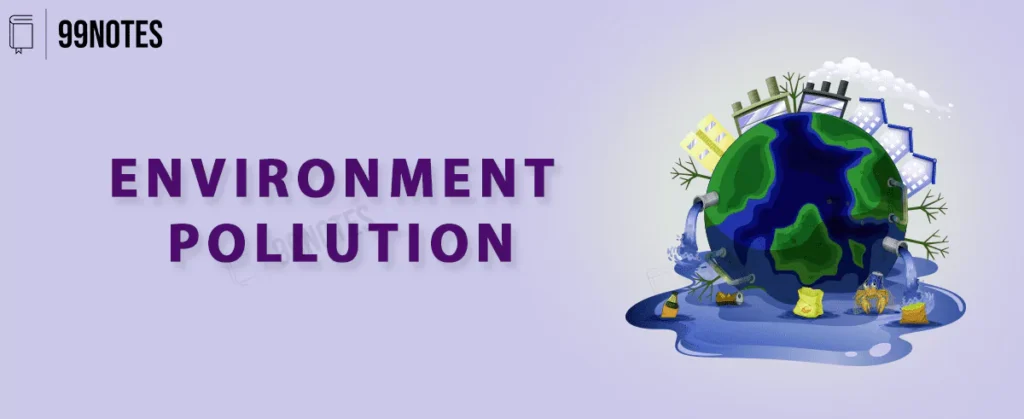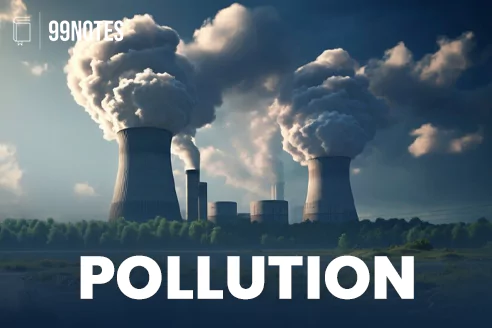
Environment Pollution Free UPSC Notes Download

Pollution
Pollution is defined as the accumulation of substances or forms of energy in an environment in quantities or at flow rates, which exceed an ecosystem’s capacity to either neutralise or disperse them to harmless levels. (RF Dasmann – 1975).

Global Warming
Global warming is the long term-warming of the planet, often calculated relative to the pre-Industrial level (c. 1850-1900). The processes that warm the atmosphere are often collectively referred to as the greenhouse effect.
Environment Pollution
Population rates have grown considerably throughout the ages. This indicates that the food supply, water, housing, power, roads, and automobiles have also increased. These requirements create a tremendous pressure on our natural resources and increase carbon dioxide, food, and soil emissions.
Involved in environmental contamination is the release of chemicals and energy from human waste products. It exists in several forms.
The following are the classes of pollutants:
1- Water Contamination
2- Noise pollution
3-Air Pollutants
4- Land contamination
Water Contamination
Humans have polluted water sources throughout the globe by dumping various types of waste into them. The Government of India adopted the Water (Environmental protection Act) Act, 1974, to safeguard our water resources, recognising the need of preserving the aquatic environment’s cleanliness.
There is no pure saltwater remaining in rivers, canals, or lakes since all irrigation systems contain trace quantities of biological and chemical suspended materials. When the concentration of these substances in water increases, both water pollution and environmental pollution as a whole increase.
Two Sources of Air Pollution
- Nature Natural effluents include, among other things, decomposition, earthquakes, degradation, and the decomposition of biological beings.
- Today, water pollution caused by humans is a major concern. Environmental degradation is caused by industrial, commercial, and growing popularity emissions.
Sources of Pollution in the Ganges and Yamuna Rivers
The majority of pollutants, including polluted wastewater treatment, poisonous gases, pharmaceutical residuals, different contaminants, dust, pollution, etc., are disposed of in moving water, lagoons, ponds, rivers, and maybe other rivers and streams. They were thus killing their biosystems. The manufacturing of calfskin, paper, garments, and chemicals are important contributors to water contamination.
Numerous types of chemicals, including inorganic fertilisers, insecticides, and insecticides, are often utilised in modern agriculture. Community activities like as pilgrimages, religious festivals, tourism, etc. also contribute to water pollution. Today, the majority of rivers and lakes in India are contaminated and unfit for human consumption.
Repercussions Of Water Pollution
The kind and amount of pollutants affects the effect. The location of rivers is also crucial in determining pollution concentrations.
Aquatic species near urban areas are becoming increasingly contaminated. This is currently the result of waste and toxic chemicals dumped by big industrial firms.
The pollution of water has a substantial effect on aquatic life. It affects their nutrition and demeanour, and causes death and disease. Dioxin is a toxin that causes a wide range of problems, including reproductive problems, epithelial development, and cancer. This chemical builds up in fish, poultry, and meat. These chemicals find their way up the food chain.
It may have a substantial impact on the food system and disrupt the ecology. Heavy metals and copper are two toxic substances that induce food poisoning in species’ seafood and, if consumed by live organisms, can continue to wreak havoc on their health.
Infectious diseases such as jaundice can be induced by human waste dumping in rivers and streams. Inadequate groundwater treatment and polluted water can potentially cause an outbreak of influenza and cholera.
Through contaminated water, the species can be badly injured, transformed, and considerably lost. The use of untreated wastewater can cause a range of moisture-related illnesses, including diarrhoea, roundworm, influenza, and others. According to the World Health Organization (WHO), about one-fourth of all transmitted illnesses in India are caused by water pollution.
Air Degradation
Air is required to support our respiratory needs. Air pollution is harmful to all living organisms. Air pollutants also affect the respiratory systems of sentient beings. The deleterious effects depend on the ratio of pollutants, the duration of exposure, and the microorganism.
In addition to harmless gases such as oxygen and nitrogen, energy sources, industrial facilities, and other companies generate solid and chemical pollutants in their smoke plumes.
Repercussions of Air Pollution
- These are the fundamental effects of air pollution:
- Multiple illnesses of the respiratory, nervous, and cardiovascular systems are caused by air pollution.
- Air pollution is the source of urban smog, which causes a hazy fog to build over cities. It has detrimental effects on human health
- Additionally, acid rain might be released into the sky. In urban areas, the entire first rainfall after July is always highly acidic, suggesting a lower pH level than subsequent rainfall.
- Dependence on fossil fuels, manufacturing, and industries that produce gaseous and particle oxides, compounds, carbon dioxide, unburned hydrocarbons, give rise, and radon are the principal reasons. The following are some of the negative consequences of air pollution:
- Due to air pollution, humans have acquired a range of cardiovascular and respiratory diseases. The incidence of mesothelioma has increased in recent decades. Children living in polluted settings have an increased risk of contracting influenza and asthma.
Planetary Warming.
Due to carbon dioxide emissions, the atomic structure of the air is imbalanced. As a result, the average surface temperature of the planet has increased. The term for this increase in stratospheric ozone is global warming. As a result of global warming, glaciers have melted and sea levels have increased. Numerous locations are fully submerged in water.
Rainfall Contamination
The burning of fossil fuels sends harmful compounds, such as hydrogen sulphide, into the atmosphere. When water droplets combine with pollutants, they become caustic and fall as sulphur dioxide, which is harmful to humans, animals, and aquatic plants.
Damage to the Ozone Layer
The release of chlorofluorocarbons, halons, and hydrochlorofluorocarbons into the atmosphere is the principal cause of ozone depletion. The depleting ozone layer provides little protection against the sun’s harmful UV radiation, which causes skin and eye problems.
Permissible noise level in India
The permitted decibel levels in industrial zones are 75 during the day and 70 at night. It is 65 dB and 55 dB throughout the day and night in commercial zones, and 55 dB and 45 dB in residential regions.
Conclusion
- The environment is defined as the surrounds of a physical system, which may communicate with other components through the transmission of mass and electricity.
- The natural environment includes both living and nonliving things. Because the environment is our home, we must protect it from harm. If we disregard the increasing pollution, it may badly impact us and future generations.
- Waste creation is detrimental to life on Earth’s surface and should be reduced as much as possible.
- Human life is dependent on the environment; thus, care should constantly be taken to maintain its integrity.
Other Topics Related to Environment:
| Vegetation and Wildlife Conservation | Disaster Management |
| Environment Impact Assessment | Agriculture |
| Current Affairs | UPSC GS 3 Syllabus & Notes |

